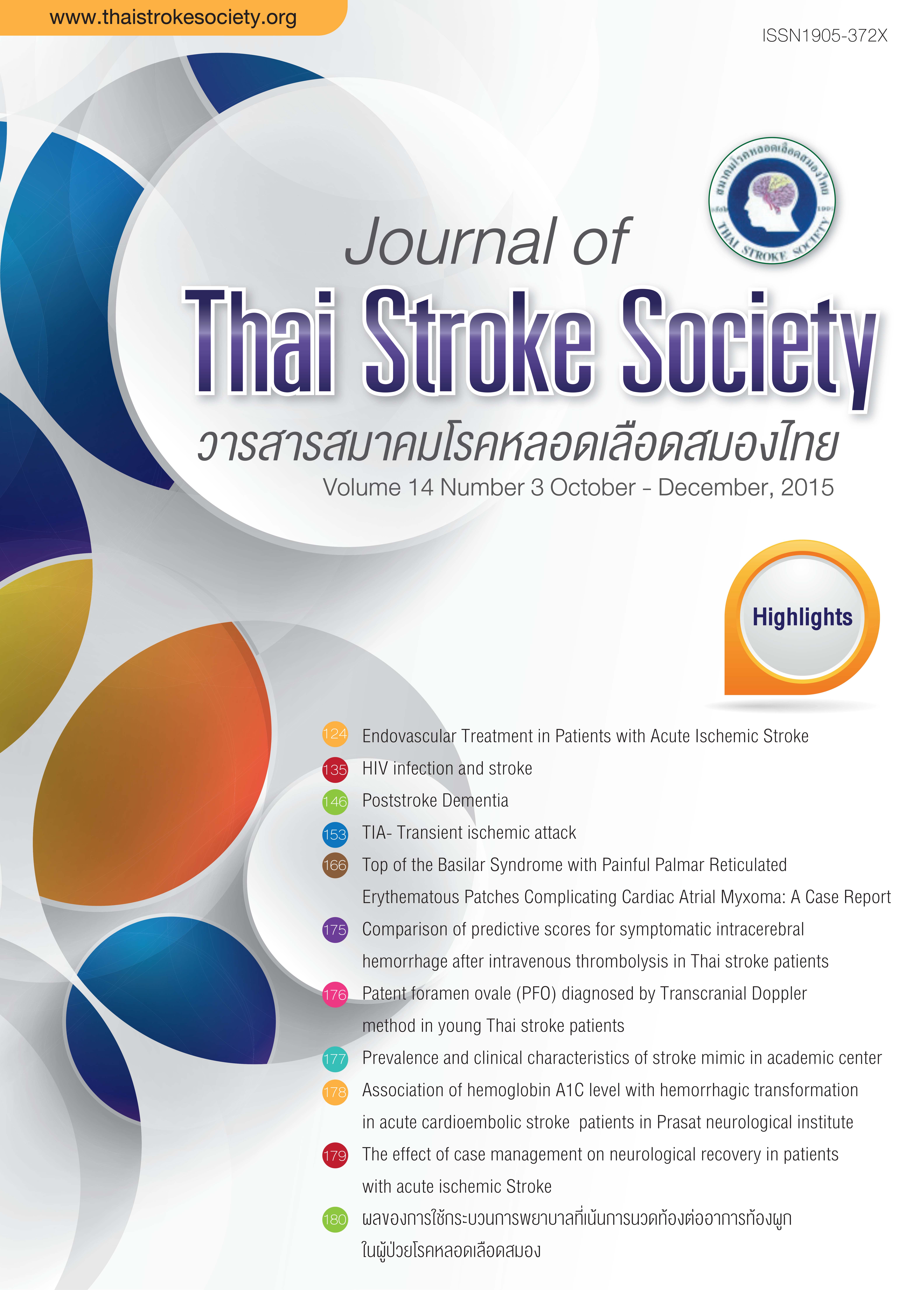Cortical venous thrombosis presenting as MCA infarction mimic
Keywords:
cortical venous thrombosis, protein S deficiency, anticoagulantAbstract
A 35-year-old male presented with headache and global aphasia without weakness for 1 day. The clinical diagnosis of left middle cerebral artery (MCA) infarction was confirmed by computed tomography (CT) brain finding of left parieto-temporal infarction. He was first treated with antiplatelet agent. The magnetic resonance imaging (MRI) brain also showed visualization of the hypointense T1/ hyperintense T2 area with restricted diffusion involving the left parietotemporal lobes, compatible with acute infarction. However, there is a tubular lesion and three-jagged edge shape with dark signal intensity in GRE images at the left parietal extra-axial space, as well as dilatation of the left vein of Labbe and prominent left superficial middle cerebral vein, draining to the left transverse sinus. Therefore the diagnosis of left parietal cortical vein thrombosis with collateral drainage was made. The further investigations revealed deficiency of protein S (free protein S= 0 % activity) with compatible with herediatary protein S deficiency. Anticoagulant was considered in this case. Left parietal cortical vein thrombosis can be MCA infarction mimic.
References
M. K. TEN KATE and J. VAN DER MEER. Protein S deficiency: a clinical perspective. Haemophilia 2008;14:1222–1228.
Hingwala D, Kesavadas C, Thomas B, Kapilamoorthy TR. Clinical utility of susceptibility-weighted imaging in vascular diseases of the brain. Neurol India.
2010;58:602–7.
Maria Carolina Pintao, Daniel D. Ribeiro,Irene D. Bezemer, et al. Protein S levels and the risk of venous thrombosis: results from the MEGA case-control
study. Blood. 2013;122(18):3210-3219.
Garcia de Frutos P, Fuentes-Prior P, Hurtado B, Sala N. Molecular basis of protein S deficiency. Thromb Haemost. 2007;98:543–56.
Borgel D, Duchemin J, Alhenc-Gelas M, Matheron C, Aiach M, Grandrille S. Molecular basis for protein S hereditary deficiency: genetic defects observed
in 118 patients with type I and type IIa deficiencies. The French network on molecular abnormalities responsible for protein C and protein S deficiencies.
J Lab Clin Med. 1996;128:218–27.
Gustavo Saposnik, Fernando Barinagarrementeria, Robert D. Brown, et al. Diagnosis and Management of Cerebral Venous Thrombosis: A Statement for
Healthcare Professionals From the American Heart Association/American Stroke Association. Stroke. 2011;42:1158-1192.
Downloads
Published
How to Cite
Issue
Section
License
ข้อความภายในบทความที่ตีพิมพ์ในวารสารสมาคมโรคหลอดเลือดสมองไทยเล่มนี้ ตลอดจนความรับผิดชอบด้านเนื้อหาและการตรวจร่างบทความเป็นของผู้นิพนธ์ ไม่เกี่ยวข้องกับกองบรรณาธิการแต่อย่างใด การนำเนื้อหา ข้อความหรือข้อคิดเห็นของบทความไปเผยแพร่ ต้องได้รับอนุญาตจากกองบรรณาธิการอย่างเป็นลายลักษณ์อักษร ผลงานที่ได้รับการตีพิมพ์ในวารสารเล่มนี้ถือเป็นลิขสิทธิ์ของวารสาร





